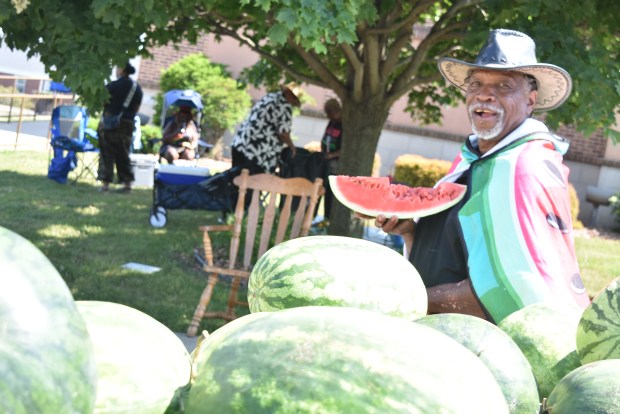Construction on the South Shore Line’s West Lake Corridor – now officially the Monon Corridor – project is about 90% done, president and general manager Michael Noland said. The Double Track NWI project is finished.
Service is set to begin by fall 2025, but he hopes it will be sooner, Noland told the Northern Indiana Commuter Transportation District board Monday during its meeting in Chesterton.
“The biggest other hurdle we’ve had is getting an agreement with CSX to build the underpass at the southern end of the project,” in the Munster/Dyer area, he said, but that agreement has now been signed by CSX.
“Activity’s taking place right now to move that part of the process forward,” Noland said. “They have to drive piles, then they have to put in a jump span. After they put in the jump span, there’s a bunch of substructure retaining walls.”
Once the prep work is done, they will start building the underpass in the spring. “When that’s done, we can start revenue service,” he said. “Right now, the contractor schedule says that happens in mid-September.”
The contractor and the South Shore Line are working to identify time-saving measures to speed completion.
“I’ve been saying May, May, May of ‘25 for a long, long time,” he said. “I’m not going to give up on May. If it’s end of May or beginning of June or sometime in that time frame, we’ll see where it winds up.”
Last month, the South Shore Line’s gateway station in north Hammond opened. That’s where both the main line – the Shoreline route – and the Monon Corridor north-south route will connect.
Moving the tracks for that project meant busing passengers until that relocation was completed.
With the $200 million project to expand capacity in Illinois, where the four rail lines narrow to three, busing will be required between the 18th Street and Millennium Park stations two weekends next month, Dec. 7-8 and 14-15. Noland said that if it had not been for the $950 million West Lake Corridor and $650 million double-track projects, that $200 million investment would have been the largest in the railroad’s history.
“It’s vital to our growth in the future,” he said. “We would not be here talking about West Lake or double track without this project.”
Just south of Van Buren, Metra’s quadruple-track railroad shrinks to three, “right at the heart of the terminal,” Noland said. “We’re just rearranging that rail yard to make it a four-track operation. It opens up 25% of the capacity, and it’s allowing us to add our current 26 trains, and actually trains in the future.”
Currently, the South Shore has just one track going into Millennium Station from that point on. “It really does open up capacity and operational flexibility,” he said.
Metra is totally reconfiguring that rail yard, Noland explained, moving catenary structures and tracks and putting in new switches, all while trains continue to operate. “We’re running 53 trains a day in there. They run 170 trains, so there’s 223 trains in and out of that terminal every single day. That doesn’t even count their deadhead moves where they move an empty set of equipment from Millennium Station to their rail yard at 18th Street, so it’s a busy environment.”
Bears fans get off the train at 18th Street to go to Soldier Field. The Van Buren Street station, for access to museums, won’t be in use those two weekends in December.
Expect some additional travel time, Noland said.
“It’s sort of like the bus bridge we did for double track for a couple of years. For a couple weekends, our passengers are going to be inconvenienced. It’s the only way to get this project done, in order to move some of these essential tracks.” Noland said.
“We’re trying to do as much work outside of the rush hour periods, where most of the people are traveling, but there still will be construction impacts from the Metra work,” he said. “It’s expected to finish up sometime in 2026, and after that, we really get a much-improved railroad.”
The South Shore Line has also begun using its new computer-aided dispatch system, one that works with the positive train control system. “It was a brand new process, and everyone in the railroad industry is watching the success of this project because we’re the unicorn. We’re the only ones that run this system across the country,” Noland said.
“We’ve been very successful since Sept. 28 and are excited about the fact that now there will be a choice in the industry,” he said.
The railroad’s board approved a $6.8 million contract for a passenger communication system that involves installing new Wi-Fi routers in every rail car. The system will be used to send announcements to passengers aboard trains and at stations, including Metra stations.
It also provides a count of passengers boarding and disembarking from each rail car to provide more accurate passenger counts.
Metra, which is still working on implementation of the system, began doing so about six or seven years ago, Noland said.
“We do reporting to the federal government on a triennial basis of ridership in particular stations, and we do have some methodology from our conductor counts on a daily basis, but they measure it at South Bend, Michigan City, Gary and then downtown Chicago,” Noland said. “I think our conductors do a nice job of giving a sense of where the ridership is, but we don’t know on any given day exactly where our ridership is.”
The computerized count will help the railroad with planning and scheduling, he said.
Doug Ross is a freelance reporter for the Post-Tribune.




